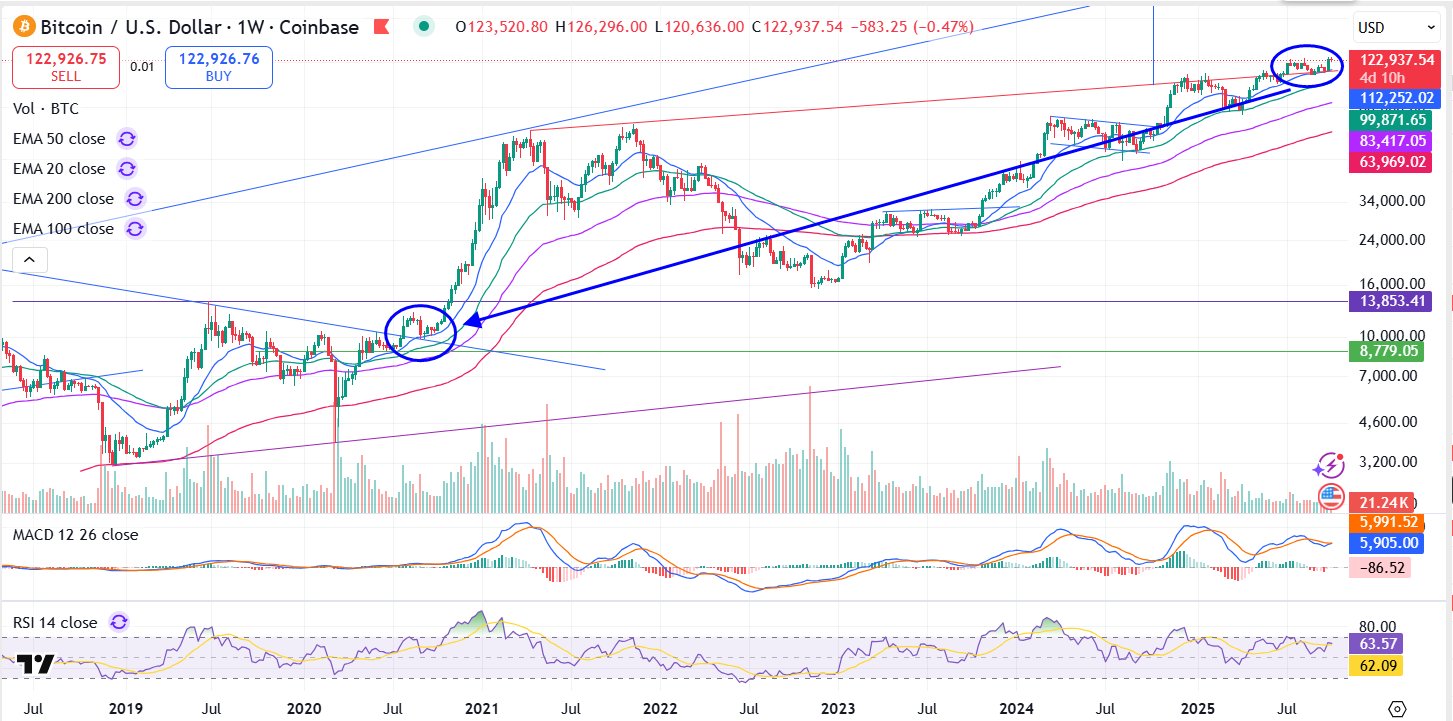In the midst of strategizing, we decide the outcome from a thousand miles away. Hello everyone, I am Lin Chao, a global financial market observer, focusing on cryptocurrency market analysis, bringing you the most in-depth trading information analysis and technical teaching.

A few days ago, a fan privately messaged me asking if we are entering a full bull market. I thought for a long time and couldn't provide an accurate answer. Subjectively, I hope for a full bull market, but rationally, I have always felt that it has already risen for so long without interest rate cuts. Although it won't end the overall bull market within the interest rate cut cycle, a monthly-level correction would still be normal. Early yesterday morning, Powell's speech was clearly very mild, indicating that it is very likely to end the balance sheet reduction in the coming months and gradually enter a quantitative easing cycle. Today, I will take you to understand the changes that may occur in the overall financial market with the end of "balance sheet reduction." We will still use the simplest words to point out what may happen in the future.

The end of the U.S. balance sheet reduction (Quantitative Tightening, QT) is a very core financial issue and a significant turning point in monetary policy, representing multi-layered meanings and potential impacts.
We can use a simple analogy to understand:
- Quantitative Easing (QE): It's like the Federal Reserve turning on the faucet, injecting "water" (releasing liquidity) into the economic system.
- Balance Sheet Reduction (QT): It's like the Federal Reserve tightening the faucet, pulling the "water" out of the pool (withdrawing liquidity).
- Stopping Balance Sheet Reduction: This means the Federal Reserve has stopped the "water extraction" action, but the water level in the pool (total liquidity) is still higher than before the water was released.
- Core Meaning: The "Normalization" Process of Monetary Policy is Coming to an End
The Federal Reserve's balance sheet has expanded significantly after multiple rounds of QE following the 2008 financial crisis and the 2020 COVID crisis. Balance sheet reduction is the core means of "normalizing" the balance sheet size. Stopping balance sheet reduction means:
- The Federal Reserve believes the current balance sheet size is close to or has reached what they consider the "appropriate level." They no longer need to further tighten the financial environment by actively selling bonds or stopping reinvestment upon maturity.
- The "quantity" part (i.e., the balance sheet) of this monetary policy tightening cycle is basically declared over. The focus will now completely shift to the "price" part (i.e., the federal funds rate) adjustments.

- Direct Signals to the Market and Economy
- Easing of liquidity tightening pressure: Balance sheet reduction is a process of continuously withdrawing liquidity from the market. Stopping balance sheet reduction means this largest "water extraction machine" has been turned off. This is a positive signal for the financial market (especially for liquidity-sensitive assets) and helps stabilize market sentiment.
- Paving the way for future policy adjustments: Stopping balance sheet reduction is a necessary precursor to the Federal Reserve adopting more accommodative policies (such as interest rate cuts). Starting to cut rates while still withdrawing liquidity from the market would send confusing policy signals. Therefore, "stopping balance sheet reduction" is usually a leading indicator of "interest rate cuts," marking the beginning of a shift in policy focus from "anti-inflation" to "preventing recession/supporting growth."
- Acknowledging the tension in the financial environment: The Federal Reserve may stop balance sheet reduction because they observe that the continuous withdrawal of liquidity has already or will soon create unnecessary pressure on the banking system (such as reserve scarcity), credit markets, etc., which could harm economic growth.

- Possible Impacts on Various Assets
U.S. Treasury Market:
Positive: Stopping balance sheet reduction means the Federal Reserve is no longer a "net seller" in the Treasury market and may even become a "net buyer" again in the future. This will reduce supply pressure on Treasuries, supporting Treasury prices and potentially leading to a decline in yields (especially long-term yields).
Stock Market:
Generally positive: The cessation of liquidity "extraction" eliminates a major uncertainty in the market. Lower bond yields also enhance the valuation attractiveness of growth stocks and tech stocks. The market typically interprets this as a "dovish" signal from the Federal Reserve.
U.S. Dollar:
Possible pressure: As the monetary policy tightening cycle comes to an end, the attractiveness of U.S. Treasury yields declines, which may weaken the appeal of dollar assets, putting downward pressure on the dollar exchange rate.
Cryptocurrency and Gold:
Positive: Stopping balance sheet reduction usually accompanies expectations of peak interest rates, which lowers the opportunity cost of holding cryptocurrencies and gold (which are non-yielding assets). At the same time, a potential weakening of the dollar is also favorable for risk assets priced in dollars.

However, it is worth noting that stopping does not equal reversal: stopping balance sheet reduction is merely a "pause in water extraction" and does not mean that a new round of QE (liquidity injection) will immediately begin. The size of the balance sheet will remain at a new, higher level for some time. Stopping balance sheet reduction and interest rate cuts are two different easing tools. History shows that stopping balance sheet reduction usually occurs after the last rate hike and before the first rate cut. It is a hallmark event of a transitional phase. The residual effects of "balance sheet reduction": even if balance sheet reduction stops, the substantial tightening effect on liquidity caused by the previous continuous reduction will still exist and continue to impact the economy, which is known as the "lag effect."
If the U.S. stops balance sheet reduction, it core represents the formal end of the Federal Reserve's current "quantitative tightening" policy. It marks the conclusion of the aggressive tightening cycle that began in 2022 and is a key "weather vane" for the shift in monetary policy. For the market, it means that the maximum suppressive factor on liquidity has been removed, providing a more favorable environment for the repricing of asset prices and clearly indicating that subsequent easing measures such as interest rate cuts are imminent. The image below shows the left blue circle representing Bitcoin's trend after the "balance sheet reduction" stopped in October 2020, and the right blue circle showing Bitcoin's current trend. Do you find them similar?

Lin Chao's Summary:
From a macro narrative perspective, several key indicators within the Federal Reserve system have almost simultaneously issued warnings in recent weeks:
The SOFR and IORB spread continues to widen. The cost of funds in the short-term financing market is becoming increasingly expensive, indicating that system liquidity is being rapidly drained. Historically, whenever the SOFR has consistently exceeded the IORB upper limit, the Federal Reserve has typically intervened in advance. The last similar situation was just before the Repo crisis in September 2019—when the Federal Reserve was forced to urgently stop balance sheet reduction and restart repos.
Bank reserves have fallen below $3 trillion. This number is a critical threshold. In 2019 and 2022, the market validated that as long as it falls below this line, liquidity risks will rapidly amplify in the repo market.
The repo rate (TGCR) briefly exceeded the reserve rate (IORB). This means the market is willing to pay more to borrow cash rather than let funds sit in central bank accounts—indicating that the "cash content" in the system has been drained. In other words: if it continues to shrink, it could "burst the system."

Therefore, I believe the conclusion is very clear: the reduction cannot continue. Once balance sheet reduction reaches a critical point, the Federal Reserve can only stop it or even reverse it. The end of balance sheet reduction often signals a turning point in the dollar liquidity cycle.
Stopping balance sheet reduction = a reversal signal for the dollar liquidity cycle, with cryptocurrencies led by Bitcoin being among the earliest and most sensitive beneficiaries of this cycle.
Internally, Powell, Bowman, and Waller have different views, but the committee is already discussing "the timing of ending balance sheet reduction" rather than "whether to continue balance sheet reduction."
So we need to pay attention to the Federal Reserve meeting minutes that will be released later at 2 AM to see if more details can be disclosed, especially in the current context of the U.S. government shutdown macro data.
Is it a full bull market? I still hold the same view, which depends on your holding period. I remain optimistic in the long term, but there are risks in the short term. After the interest rate cut expectations came out last night, the market did not have a strong rebound. High leverage long and short positions are not suitable in the short term; let's continue to wait for a significant opportunity after clarity. The market is cruel, and there are not so many conspiracies; enhancing cognition and managing risk well are your best core competencies.
It may not be now, but this could be the eve of a full bull market.

If you are in confusion—don’t understand technology, don’t know how to read charts, don’t know when to enter the market, don’t know how to stop loss, don’t understand take profit, randomly increase positions, get stuck while bottom-fishing, can’t hold onto profits, miss opportunities… these are common problems for retail investors. Lin Chao can help you establish the correct trading mindset. A single profitable trade is worth more than a thousand words; finding the right direction is better than repeatedly failing. Instead of frequent operations, it’s better to strike precisely, making each trade more valuable.
The success of investment depends not only on choosing good targets but also on when to buy and sell. Protecting your principal and doing proper asset allocation is essential for steady progress in the ocean of investment. Life is like a long river flowing into the sea; what determines victory or defeat is never the gains and losses of a single pass or a moment, but rather planning before action and knowing when to stop to gain.
The global market is ever-changing, and the world is a whole. Follow Lin Chao to gain a top-tier global financial perspective.
This article is merely a personal opinion and does not constitute any trading advice. The cryptocurrency market has risks; invest cautiously!

For real-time consultation, feel free to follow the public account: Lin Chao on Cryptocurrency.
免责声明:本文章仅代表作者个人观点,不代表本平台的立场和观点。本文章仅供信息分享,不构成对任何人的任何投资建议。用户与作者之间的任何争议,与本平台无关。如网页中刊载的文章或图片涉及侵权,请提供相关的权利证明和身份证明发送邮件到support@aicoin.com,本平台相关工作人员将会进行核查。




